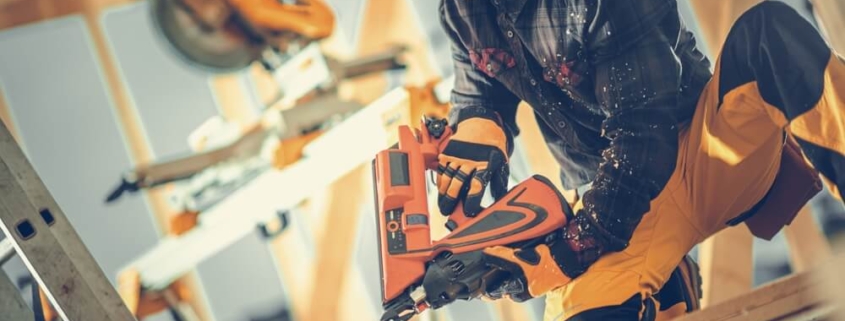Nail Gun Safety
Nail guns are handy tools that shortcut the time it takes to install many different types of materials, like drywall, trim boards, and roofing shingles. They are commonly used by construction workers and contractors in residential and commercial construction projects. Unfortunately, nail gun injuries are incredibly common. Here’s what you need to know about these painful injuries and how nail gun safety can help prevent them.
The Dangers of Nail Guns
Nail guns are powerful pieces of machinery that boost productivity on the job site. For the most part, these devices have replaced hammers in frame construction projects to speed up work. The most common types of nail guns are pneumatic (compressed air), powder-activated (explosive cartridge), and electrical.
While nail guns are useful, they are also dangerous. According to the Centers for Disease Control (CDC), these devices are the leading cause of injury among residential carpenters. They are responsible for roughly 37,000 emergency room visits annually, 60% of which are work-related.
Workers using “bump nailers” or contract trip devices are particularly at risk of injury because these tools lack a sequential trigger. One of the most common types of injuries related to nail guns is accidental firing of the tools, followed by recoil injuries. Some workers who aren’t even using the tools become injured.
These tools can cause serious injuries, including puncture wounds to the fingers and hands. However, because the most common nail guns use compressed air, more accidents can lead to severe injuries and even death.
How to Stay Safe Using Nail Guns
It takes proper training, protection, and safety measures to prevent nail gun injuries in the workplace. The Occupational Health and Safety Administration has created a Nail Gun Safety guide for construction contractors that includes recommendations for the safe use of nail guns. Some of OSHA’s recommendations include:
1. Use Full Sequential Trigger Nail Guns
A full sequential trigger nail gun is the safest type of tool. It will only fire a nail when the controls are activated in a specific order. The safety contact tip must first be pushed into the work surface. Then, the worker squeezes the trigger to fire a nail. Both the safety contact tip and the trigger must be released and activated again before another nail can be fired. While using this type of tool might take more time, it is considered safer than other versions of nail guns.
2. Provide Nail Gun Training
Both new and seasoned workers should receive in-depth safety training on the causes of nail gun injuries, how to prevent them, and what to do if they happen. The training should cover how nail guns work, the ways to load and operate a nail gun safely, and how to identify hazards that could lead to an injury.
3. Establish Nail Gun Work Procedures
Any business working with nail guns should create policies and procedures that address the risks of these tools and create the safest possible work environment. For example, employers should make sure that the manuals for each tool are available, workers inspect tools before use and check surfaces carefully before nailing. Workers should also never bypass safety features or fire a nail gun in the direction of another person.
4. Provide Personal Protective Equipment (PPE)
OSHA encourages the use of personal protective equipment to reduce the potential for serious injuries. When working with nail guns, workers should wear steal-toed safety shoes, hard hats, hearing protection, and high-impact eye protection. Employers should provide this equipment to workers at no cost and train them on how to safely use it.
5. Encourage the Discussion of Close Calls and Injuries
Unfortunately, many nail gun injuries go unreported. If they aren’t reported, there’s a good chance no one will learn anything from the experience, and someone will get hurt in the same way down the road. OSHA urges employers to report all nail gun injuries and openly discuss these incidents with workers to improve overall workplace safety.
Are You Practicing Nail Gun Safety in Your Workplace?
Failing to practice nail gun safety at work can lead to serious accidents and traumatic injuries. The most tragic thing is that these events are entirely preventable. If you’ve been injured while working with or around nail guns, it’s critical you understand your rights under OSHA.
Every employer has an obligation to provide workers with a safe workplace that protects them from harm. Training and appropriate safeguards are important parts of workplace preparedness. To learn more about protecting and asserting your rights, contact OSHA Injury Attorney directly.




Leave a Reply
Want to join the discussion?Feel free to contribute!